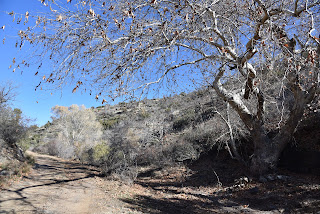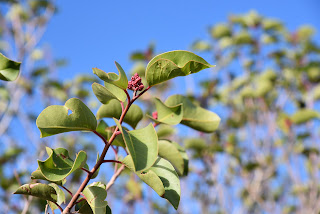WALNUT SPRING CANYON
 |
| Cottonwoods herald the approach to Walnut Spring |
There are more than seven springs in the Seven Springs Recreation Area. The Tonto National Forest site which offers a picnic area, primitive camping and trailheads anchored by the Cave Creek Trail No. 4 is home to dozens of seeping water sources.
 |
| Humboldt Mountain rises over desert scrub |
In addition to the eponymous Seven Springs, Maggie May, Mashakattee, Quien Sabe, Walnut, CP and Cottonwood springs spill water into the area’s creeks and washes.
 |
| Big vistas on the hike's high points |
 |
| The route crosses Walnut Spring Canyon several times |
A quick review of the national forest map reveals the locations of numerous other springs tucked into the mountainous backcountry north of Cave Creek. While some of the springs are located along roads and trails, most trickle in oblivion among catclaw-riddled ravines.
 |
| The hike begins with a crossing of Seven Springs Wash |
 |
| A lone sycamore grows in a moist pocket of Walnut Spring Canyon |
Among the lot, Walnut Spring is easy to visit by hiking along a dirt two-track that roughly traces the gorge of Walnut Spring Canyon.
 |
| A canyon-bound section of FR 1094 |
The trip begins on Forest Road 254 with an immediate crossing of Seven Springs Wash. Right from the start, charred tree stumps stand as reminders of the 2005 Cave Creek Complex Fire and the 2020 Sears Fire, both of which took a heavy toll in the area. Still, plenty of hardy junipers, sugar sumacs and cacti patches have survived and resurgent vegetation is gradually filling the charred voids. At the 0.3-mile point, the road meets a cattle guard where the route splits. Veer right onto Forest Road 1094, a rough route that’s open to motorized use, which serves as the trail for the remainder of the hike.
 |
| Yuccas grow in a canyon cove |
The road passes under some power lines where there’s a muddy wildlife water hole that reflects nice views of 5,175-foot Humboldt Mountain, the prominent, FAA “golf ball”-tower-topped peak to the east. An easy ascent opens up vistas of the Cave Creek Mountains and the long, flat structure of New River Mesa to the west before the road meets the cut of Walnut Spring Canyon at the 1.2-mile point and begins a moderate descent to the first of several crossings of the sinuous, boulder-cluttered course. Sheer rock faces with clinging cacti and yuccas dangling from damp crevasses gradually close in on the road and create shallow, sandy pools in abrupt bends. The residual puddles foster a tiny community of water-loving sycamore, seep willows and cottonwood trees.
 |
| A metal tank captures water from Walnut Spring |
After a short traverse of the canyon floor, the road heads uphill, hanging close to the edge as it undulates through water-ravaged gullies and drainages. The approach to Walnut Spring is heralded by a pair of cottonwood trees poking up through a tangle of junipers and a glassy slip of water running over the road. At 2.6 miles, a metal tank tucked into a slim, heavily-wooded nook, captures Walnut Spring water through a quagmire of pipes and hoses.
 |
| Sugar sumac grows along the route |
While the spring makes for a good turnaround point, a short stroll up to the ridge above it rewards with excellent mountain views of Bronco Butte and Butte Peak to the south.
 |
| New River Mesa on the west horizon |
 |
| A view of the Cave Creek Mountains from FR 1094 |
To add length to the hike, consult the forest map for roads and trails open for exploration.
 |
| Cottonwood trees thrive around Walnut Spring |
 |
| The road passes by a wildlife water hole |
LENGTH: 5.34 miles roundtrip
RATING: moderate
ELEVATION:
3,440 – 3,946 feet (1,012 feet of accumulated elevation change)
GETTING THERE:
From the Loop 101 in Scottsdale, take the Pima/Princess Road exit 36 and go 13 miles north on Pima to Cave Creek Road. Turn right (east) and go 11 miles on Cave Creek Road (a.k.a Forest Road 24 and Seven Springs Road) to Forest Road Road 254 on the right. For reference, this is about 1.5 miles south of the Seven Springs Picnic Area. Park in the dirt turnoff or, for those with high-clearance vehicles, there are several dirt parking aprons farther up FR254. Access roads are a mixture of pavement and good dirt passable by passenger cars when dry. Two minor creek crossings on cement are require. Do not attempt after heavy rains as the roads and trails are prone to flooding.
INFO:
Tonto National Forest, Cave Creek Ranger District





No comments:
Post a Comment